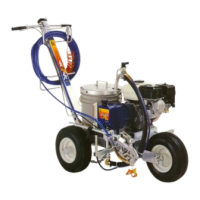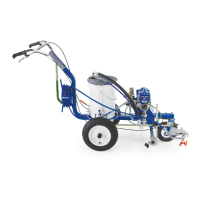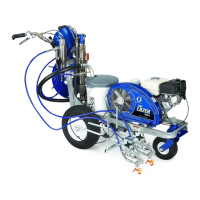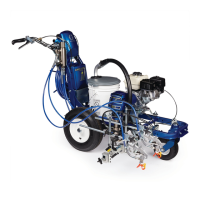Flushing
WARNING
T
o reduce the risk of serious injury whenever you
are instructed to relieve pressure, always follow the
Pressure Relief Procedure
on page 7.
Be sure the pump is properly grounded.
CAUTION
Never leave water in the sprayer if the is any chance
it could freeze. Push the water out with compatible
solvent. W
ater frozen in the pressure control tube
prevents the sprayer from being started, and causes
serious damage to the pressure control.
When to Flush
1. Flush
a new sprayer to remove the protective oil.
Before using water–base paint,
use compatible sol
-
vent, then soapy water, and then clean water
.
Before
using oil–base paint,
use compatible solvent.
2. Changing
colors. Use a compatible solvent.
3. Changing from water–base to oil–base paint. Use
warm,
soapy water
, and then a compatible solvent.
4. Changing
from oil–base to water–base paint. Use
a
compatible solvent, then warm, soapy water , and
then
clean water
.
5. Storage. After the compatible solvent flush, relieve
pressure,
but do not drain the compatible solvent.
6.
Startup after storage.
Before
using water–base paint
,
flush out the compat
-
ible solvent with soapy water , and then with clean
water.
When
using oil–based paint,
flush out the compatible
solvent
with the paint to be sprayed.
How to Flush
1. Relieve
pressure.
2. Remove
the filter bowl (A)
and screen (B); see manu
-
al
307–273. Install the
bowl and support (C), without
the screen, to flush it. Clean the screen separately .
See
Fig. 8.
3.
Close the pressure drain valve (13).
4. Put the suction tube in a grounded pail of water or
solvent.
5. Remove the gun(s) from the holder . Remove the
spray
tip(s) to prevent splashing.
WARNING
T
o reduce the risk of static sparking and splashing
when flushing, always remove the spray tip from
the gun, and hold a metal part of the gun firmly to
the side of, and aimed into, a grounded metal pail.
6.
Follow
Startup
on page 13. Keep the gun triggered
until clean water or solvent comes from the nozzle.
See
Fig. 9. Release the trigger and engage the gun
safety latch.
NOTE: If you have two guns, release the trigger safety
latch on the second gun and trigger that gun until clean
water
or solvent comes
from the nozzle. T
o ensure that
the
hoses are well-flushed, flush the first gun and then the
second
gun at least one more time.
7. Check all fluid connections for leaks. Relieve pres-
sure before tightening any connections. Start the
sprayer.
Recheck the connections for leaks.
8. Remove the suction tube from the solvent pail. Dis-
engage
the gun safety latch. T
rigger the gun to
force
water
or solvent from the hose. Do not let the pump
run
dry for more than 30 seconds to avoid damaging
the
pump packings! Relieve pressure.
Fig. 8
B
C
0013
A
13
Fig. 9
0014
Maintain
firm metal-
to-metal contact
when flushing to
reduce the chance
of static sparking
and splashing.
9. If
you have been
spraying paint, remove the strainer
,
suction
tube and suction hose and clean them sepa
-
rately
to be sure all paint sediment is removed. Dried
paint
in the suction tube assembly can build up and
cause performance problems later on.
10. Install
the clean filter screen.
Install the filter bowl and
hand
tighten.
11. See Storage or Changing Colors, above. Relieve
pressure.
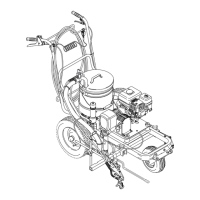
